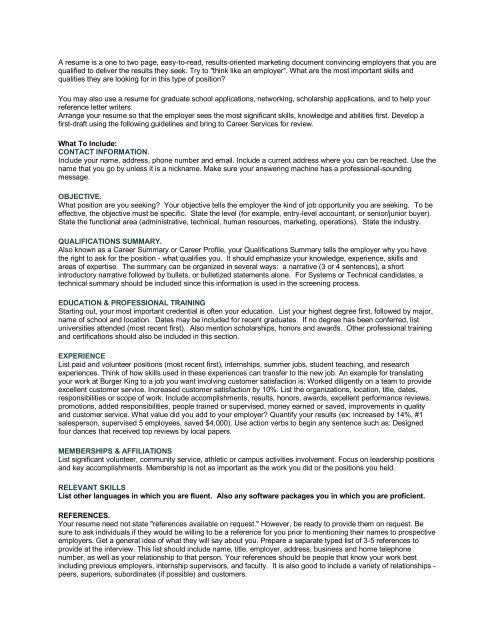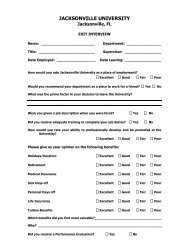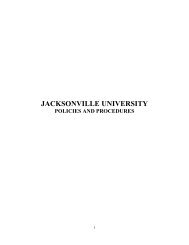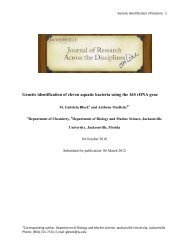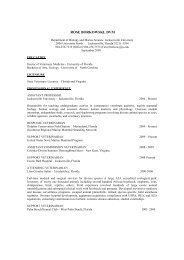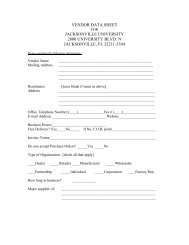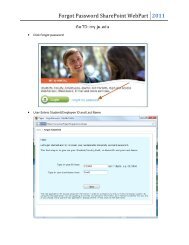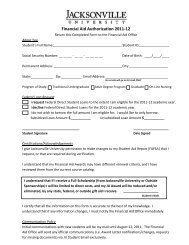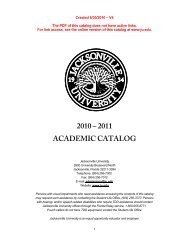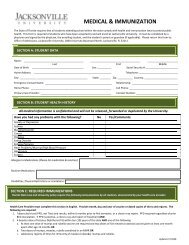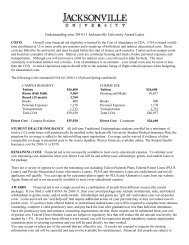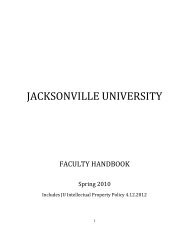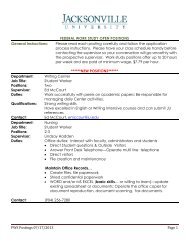A resume is a one to two page, easy-to-read, results-oriented ...
A resume is a one to two page, easy-to-read, results-oriented ...
A resume is a one to two page, easy-to-read, results-oriented ...
Create successful ePaper yourself
Turn your PDF publications into a flip-book with our unique Google optimized e-Paper software.
A <strong>resume</strong> <strong>is</strong> a <strong>one</strong> <strong>to</strong> <strong>two</strong> <strong>page</strong>, <strong>easy</strong>-<strong>to</strong>-<strong>read</strong>, <strong>results</strong>-<strong>oriented</strong> marketing document convincing employers that you are<br />
qualified <strong>to</strong> deliver the <strong>results</strong> they seek. Try <strong>to</strong> "think like an employer". What are the most important skills and<br />
qualities they are looking for in th<strong>is</strong> type of position?<br />
You may also use a <strong>resume</strong> for graduate school applications, ne<strong>two</strong>rking, scholarship applications, and <strong>to</strong> help your<br />
reference letter writers.<br />
Arrange your <strong>resume</strong> so that the employer sees the most significant skills, knowledge and abilities first. Develop a<br />
first-draft using the following guidelines and bring <strong>to</strong> Career Services for review.<br />
What To Include:<br />
CONTACT INFORMATION.<br />
Include your name, address, ph<strong>one</strong> number and email. Include a current address where you can be reached. Use the<br />
name that you go by unless it <strong>is</strong> a nickname. Make sure your answering machine has a professional-sounding<br />
message.<br />
OBJECTIVE.<br />
What position are you seeking? Your objective tells the employer the kind of job opportunity you are seeking. To be<br />
effective, the objective must be specific. State the level (for example, entry-level accountant, or senior/junior buyer).<br />
State the functional area (admin<strong>is</strong>trative, technical, human resources, marketing, operations). State the industry.<br />
QUALIFICATIONS SUMMARY.<br />
Also known as a Career Summary or Career Profile, your Qualifications Summary tells the employer why you have<br />
the right <strong>to</strong> ask for the position - what qualifies you. It should emphasize your knowledge, experience, skills and<br />
areas of expert<strong>is</strong>e. The summary can be organized in several ways: a narrative (3 or 4 sentences), a short<br />
introduc<strong>to</strong>ry narrative followed by bullets, or bulletized statements al<strong>one</strong>. For Systems or Technical candidates, a<br />
technical summary should be included since th<strong>is</strong> information <strong>is</strong> used in the screening process.<br />
EDUCATION & PROFESSIONAL TRAINING<br />
Starting out, your most important credential <strong>is</strong> often your education. L<strong>is</strong>t your highest degree first, followed by major,<br />
name of school and location. Dates may be included for recent graduates. If no degree has been conferred, l<strong>is</strong>t<br />
universities attended (most recent first). Also mention scholarships, honors and awards. Other professional training<br />
and certifications should also be included in th<strong>is</strong> section.<br />
EXPERIENCE<br />
L<strong>is</strong>t paid and volunteer positions (most recent first), internships, summer jobs, student teaching, and research<br />
experiences. Think of how skills used in these experiences can transfer <strong>to</strong> the new job. An example for translating<br />
your work at Burger King <strong>to</strong> a job you want involving cus<strong>to</strong>mer sat<strong>is</strong>faction <strong>is</strong>: Worked diligently on a team <strong>to</strong> provide<br />
excellent cus<strong>to</strong>mer service. Increased cus<strong>to</strong>mer sat<strong>is</strong>faction by 10%. L<strong>is</strong>t the organizations, location, title, dates,<br />
responsibilities or scope of work. Include accompl<strong>is</strong>hments, <strong>results</strong>, honors, awards, excellent performance reviews,<br />
promotions, added responsibilities, people trained or superv<strong>is</strong>ed, m<strong>one</strong>y earned or saved, improvements in quality<br />
and cus<strong>to</strong>mer service. What value did you add <strong>to</strong> your employer? Quantify your <strong>results</strong> (ex: increased by 14%, #1<br />
salesperson, superv<strong>is</strong>ed 5 employees, saved $4,000). Use action verbs <strong>to</strong> begin any sentence such as: Designed<br />
four dances that received <strong>to</strong>p reviews by local papers.<br />
MEMBERSHIPS & AFFILIATIONS<br />
L<strong>is</strong>t significant volunteer, community service, athletic or campus activities involvement. Focus on leadership positions<br />
and key accompl<strong>is</strong>hments. Membership <strong>is</strong> not as important as the work you did or the positions you held.<br />
RELEVANT SKILLS<br />
L<strong>is</strong>t other languages in which you are fluent. Also any software packages you in which you are proficient.<br />
REFERENCES.<br />
Your <strong>resume</strong> need not state "references available on request." However, be <strong>read</strong>y <strong>to</strong> provide them on request. Be<br />
sure <strong>to</strong> ask individuals if they would be willing <strong>to</strong> be a reference for you prior <strong>to</strong> mentioning their names <strong>to</strong> prospective<br />
employers. Get a general idea of what they will say about you. Prepare a separate typed l<strong>is</strong>t of 3-5 references <strong>to</strong><br />
provide at the interview. Th<strong>is</strong> l<strong>is</strong>t should include name, title, employer, address, business and home teleph<strong>one</strong><br />
number, as well as your relationship <strong>to</strong> that person. Your references should be people that know your work best<br />
including previous employers, internship superv<strong>is</strong>ors, and faculty. It <strong>is</strong> also good <strong>to</strong> include a variety of relationships -<br />
peers, superiors, subordinates (if possible) and cus<strong>to</strong>mers.
Questions <strong>to</strong> ask about your <strong>resume</strong>, once it <strong>is</strong> completed:<br />
Is it brief, and <strong>to</strong> the point?<br />
Are your achievements prominently highlighted?<br />
Will the employer know your strongest skills by <strong>read</strong>ing your <strong>resume</strong>?<br />
Do they know the job you are seeking?<br />
Are you qualified for the position you seek?<br />
Will the employer be able <strong>to</strong> contact you easily?<br />
Check for grammar. Ask a fellow student or some<strong>one</strong> else you know <strong>to</strong> review it for you. M<strong>is</strong>spellings and<br />
poorly constructed sentences communicate negative impressions about a candidate.<br />
Ensure that your <strong>resume</strong> <strong>is</strong> neat and v<strong>is</strong>ually appealing. Choose high quality paper in white or off-white.<br />
Have the final version printed on a laser printer.<br />
HAVING TROUBLE STARTING A RESUME?.<br />
Start with several pieces of blank paper. L<strong>is</strong>t the headings for each section, and begin with the last section first,<br />
working backwards. Don't limit yourself at th<strong>is</strong> point; l<strong>is</strong>t everything, even if it seems trivial. Your Qualifications<br />
Summary <strong>is</strong> the most difficult section - do it last.<br />
Education: l<strong>is</strong>t colleges and universities attended, exchange programs, high school, off-campus study, etc.<br />
Work: l<strong>is</strong>t all jobs held-full or part time, paid or unpaid.<br />
Activities: l<strong>is</strong>t everything you have d<strong>one</strong>, now and in high school, in terms of organized groups, teams, clubs,<br />
community involvement, etc.<br />
Honors and Awards: l<strong>is</strong>t scholarships, class standing, special recognition and academic achievements.<br />
For each section ask yourself the following questions:<br />
Is th<strong>is</strong> a skill that the employer <strong>is</strong> looking for in th<strong>is</strong> type of position?<br />
How can I describe the way in which these skills can be used <strong>to</strong> benefit th<strong>is</strong> employer? For example, being a<br />
robust member of a fraternity may not be all that earth-shaking <strong>to</strong> an employer, however, the fact that you<br />
organized philanthropic functions <strong>to</strong> help the community may be of interest.<br />
Are there things on th<strong>is</strong> l<strong>is</strong>t that I feel a sense of pride or accompl<strong>is</strong>hment about?<br />
Which things on my l<strong>is</strong>t show different aspects of my personality or strengths?<br />
Your job flipping hamburgers or mowing lawns may seem trivial <strong>to</strong> you, but being a conscientious worker<br />
during these jobs may be pertinent information.<br />
Develop a first draft of your <strong>resume</strong> and bring it by Career Services for review.


